Spouters’ Corner has been accustomed to comings and goings for a very long time. The leisure complex occupies an open-air meeting place, hence its name, which was partly occupied by the blacksmith’s forge established by George Chesser in 1770. Chesser’s smithy served the passing trade on High Road and operated on this site into the 1920s.
Photographs and text about Spouter’s Corner.
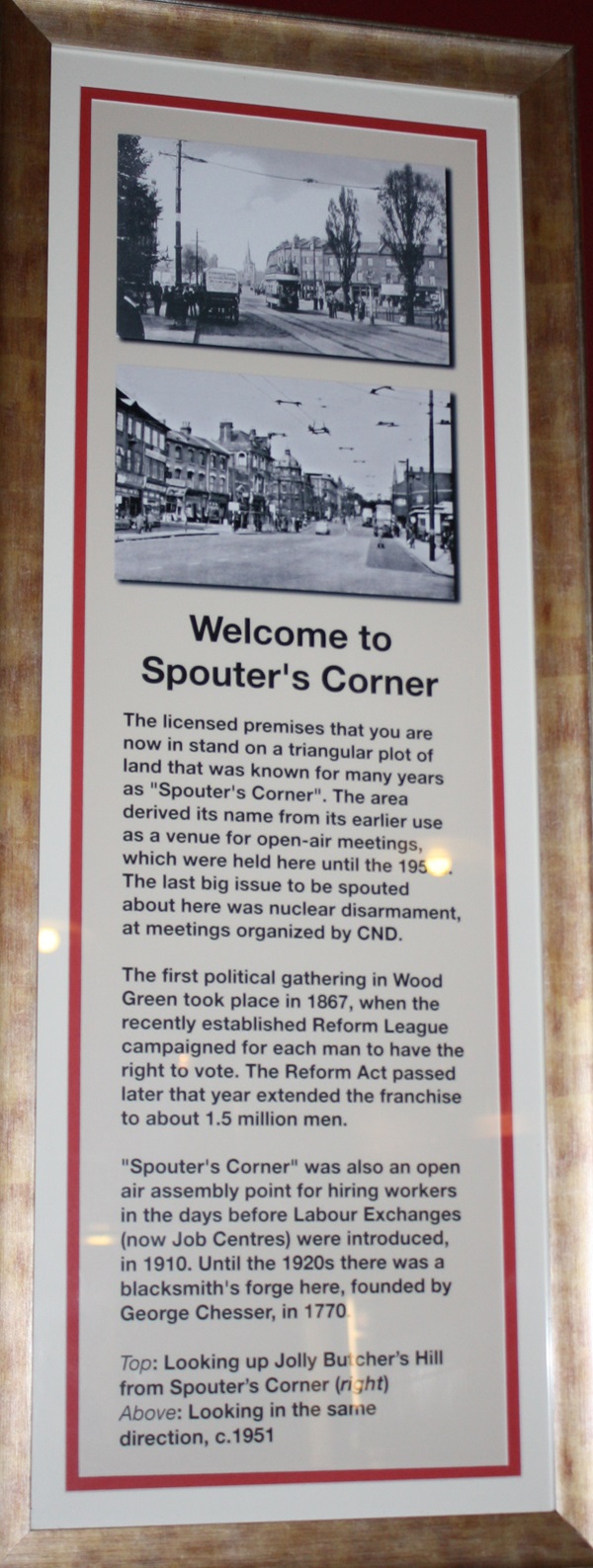
The text reads: The licensed premises that you are now in stand on a triangular plot of land that was known for many years as “Spouter’s Corner”. The area derived its name from its earlier use as a venue for open-air meetings, which were held here until the 1950s. The last big issue to be spouted about here was nuclear disarmament, at meetings organised by CND.
The first political gathering in Wood Green took place in 1867, when the recently established Reform League campaigned for each man to have the right to vote. The Reform Act passed later that year extended the franchise to about 1.5 million men.
“Spouter’s Corner” was also an open air assembly point for hiring workers in the days before Labour Exchanges (now Job Centres) were introduced, in 1910. Until the 1920s there was a blacksmith’s forge here, founded by George Chesser, in 1770.
Top: Looking up Jolly Butcher’s Hill from Spouter’s Corner (right)
Above: Looking in the same direction, c1951.
Photographs and text about George Barratt’s sweet business.
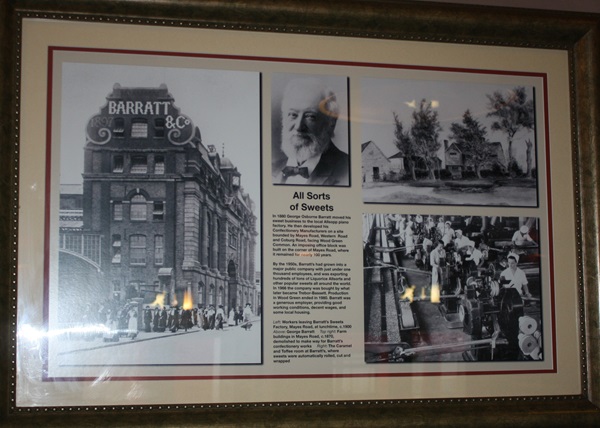
The text reads: In 1880 George Osborne Barratt moved his sweet business to the local Allsopp piano factory. He then developed his Confectionery Manufactures on a site bounded by Mayes Road, Western Road and Coburg Road, facing Wood Green Common. An imposing office block was built on the corner of Mayes Road, where it remained for nearly 100 years.
By the 1950s, Barratt’s had grown into a major public company with just under one thousand employees, and was exporting hundreds of tons of Liquorice Allsorts and other popular sweets all around the world. In 1966 the company was bought by what later became Trebor-Bassett. Production in Wood Green ended in 1980. Barratt was a generous employer, providing good working conditions, decent wages, and some local housing.
Left: Workers leaving Barratt’s Sweets Factory, Mayes Road, at lunchtime, c1900
Above: George Barratt
Top Right: Farm buildings in Mayes Road, c1870, demolished to make way for Barratt’s Confectionary works
Right: The Caramel and Toffee room at Barratt’s, where sweets were automatically rolled, cut and wrapped.
Photographs and text about Jack Hawkins.
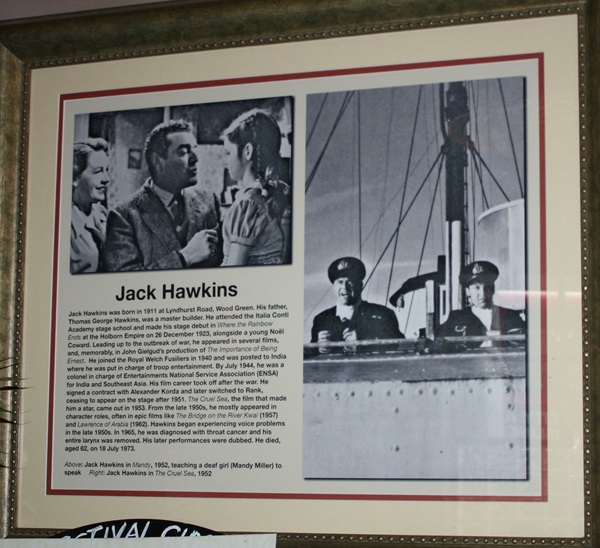
The text reads: John Hawkins was born in 1911 at Lyndhurst Road, Wood Green. His father, Thomas George Hawkins, was a master builder. He attended the Italia Conti Academy stage school and made his stage debut in Where The Rainbow Ends at the Holborn Empire on 26 December 1923, alongside a young Noël Coward. Leading up to the outbreak of war, he appeared in several films, and memorably, in John Gielgud’s production of The Importance of Being Ernest. He joined the Royal Welch Fusiliers in 1940 and was posted to India where he was put in charge of Entertainments National Service Association (ENSA) for India and Southeast Asia. His film career took off after the war. He signed a contract with Alexander Korda and later switched to Rank, ceasing to appear on the stage after 1951. The Cruel Sea, the film that made him a star, came out in 1953. From the late 1950s, he mostly appeared in character roles, often in epic films like The Bridge of the River Kwai (1957) and Lawrence of Arabia (1962). Hawkins began experiencing voice problems in the 1950s. In 1965, he was diagnosed with throat cancer and his entire larynx was removed. His later performances were dubbed. He died, aged 62, on 18 July 1973.
Above: Jack Hawkins in Mandy, 1952, teaching a deaf girl (Mandy Miller) to speak
Right: Jack Hawkins in The Cruel Sea, 1952.
Photographs and text about theatres in Wood Green.
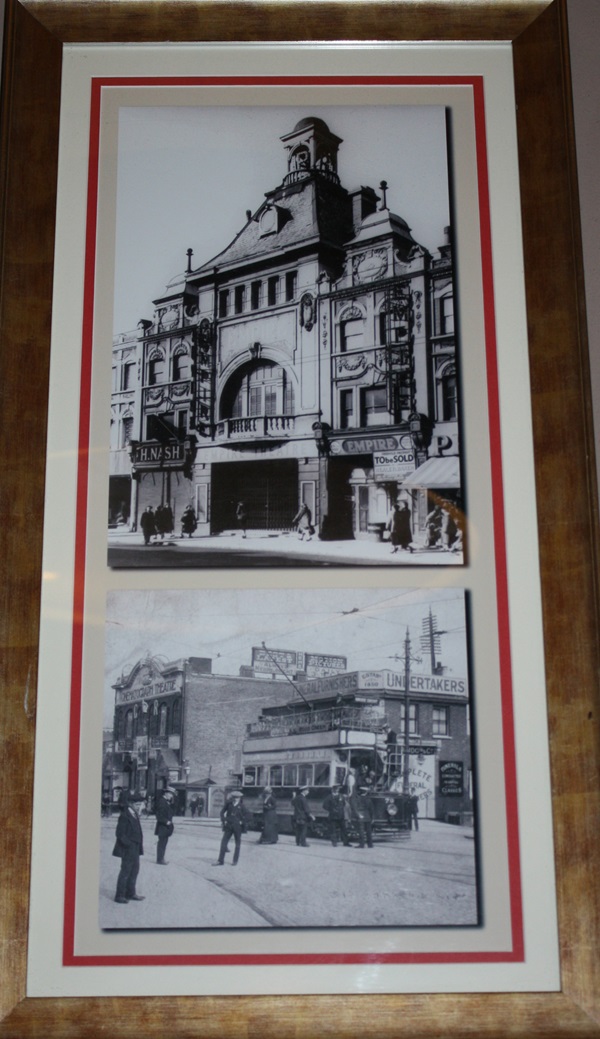
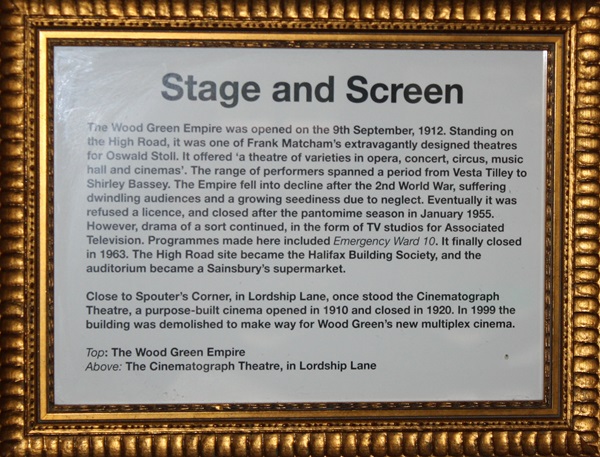
The text reads: The Wood Green Empire was opened on the 9 September, 1912. Standing on the High Road, it was one of Frank Matcham’s extravagantly designed theatres for Oswald Stoll. It offered ‘a theatre of varieties in opera, concert, circus, music hall and cinemas’. The range of performers spanned a period from Vesta Tilley to Shirley Bassey. The Empire fell into decline after the 2nd World War, suffering dwindling audiences and a growing seediness due to neglect. Eventually it was refused a licence, and closed after the pantomime season in January 1955. However, drama of a sort continued, in the form of TV studios for Associated Television. Programmes made here included Emergency Ward 10. It finally closed in 1963. The High Road site became the Halifax Building Society, and the auditorium became a Sainsbury’s Supermarket.
Close to Spouter’s Corner, in Lordship Lane, once stood the Cinematograph Theatre, a purpose-built cinema opened in 1910 and closed in 1920. In 1999 the building was demolished to make way for Wood Green’s new multiplex cinema.
Top: The Wood Green Empire
Above: The Cinematograph Theatre, in Lordship Lane.
An illustration, photograph and text about Alexandra Palace.
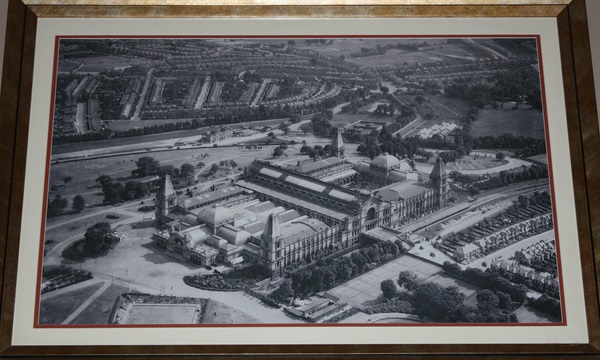
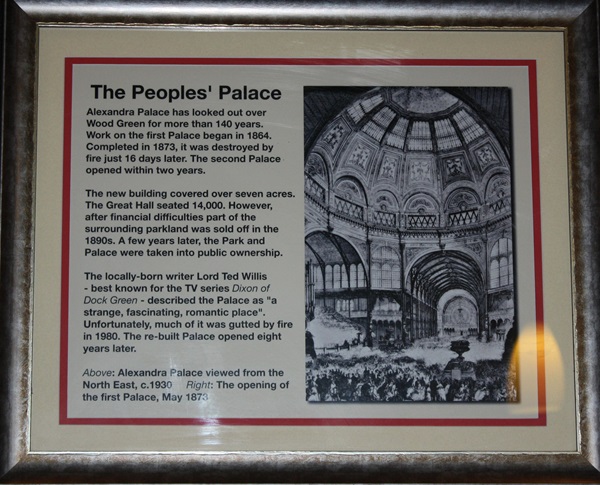
The text reads: Alexandra Palace has looked out over Wood Green for more than 140 years. Work on the first Palace began in 1864. Completed in 1873, it was destroyed by fire just 16 days later. The second Palace opened within two years.
The new building covered over seven acres. The Great Hall seated 14,000. However, after financial difficulties part of the surrounding parkland was sold off in the 1890s. A few years later, the Park and Palace were taken into public ownership.
The locally-born writer Lord Ted Willis – best known for the TV series Dixon of Dock Green – described the Palace as “a strange, fascinating, romantic place”. Unfortunately, much of it was gutted by fire in 1980. The re-built Palace opened eight years later.
Above: Alexandra Palace viewed from then North East, c1930
Right: The opening of the first Palace, May 1873.
Photographs and text about clay and pottery.
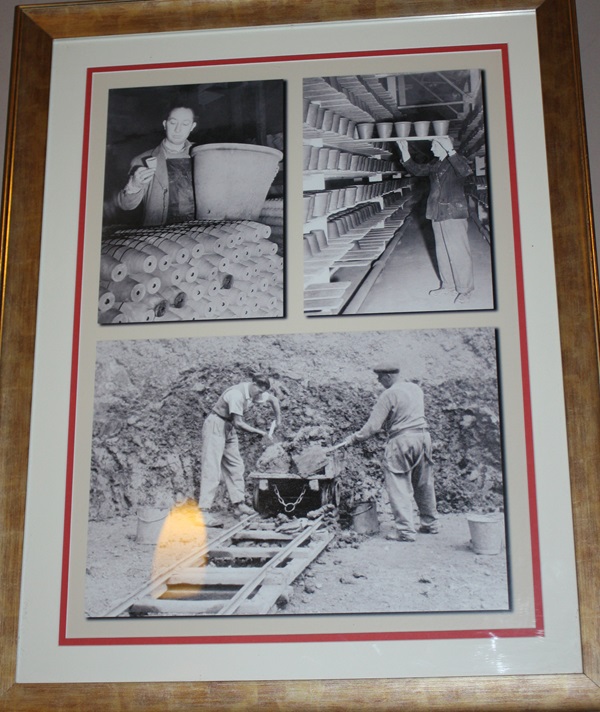
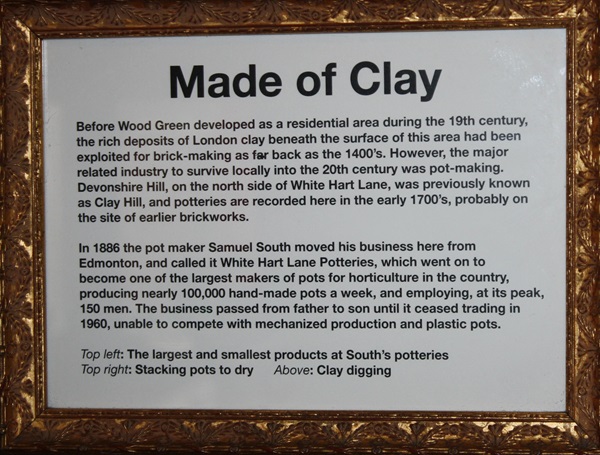
The text reads: Before Wood Green developed as a residential area during the 19th century, the rich deposits of London clay beneath the surface of this area had been exploited for brick-making as far back as the 1400s. However, the major related industry to survive locally into the 20th century was pot-making. Devonshire Hill, on the north side of White Hart Lane, was previously known as Clay Hill, and potteries are recorded here in the early 1700s, probably on the site of earlier brickworks.
In 1866 the pot maker Samuel South moved his business here from Edmonton, and called it White Hart Lane Potteries, which went on to become of the largest makers of posts for horticulture in the country, producing nearly 100,000 hand-made pots a week, and employing, at its peak, 150 men. The business passed from father to son until it ceased trading in 1960, unable to compete with mechanized production and plastic pots.
Top left: The largest and smallest products at South’s potteries
Top right: Stacking pots to dry
Above: Clay digging.
Illustrations and text about William Cobbett.
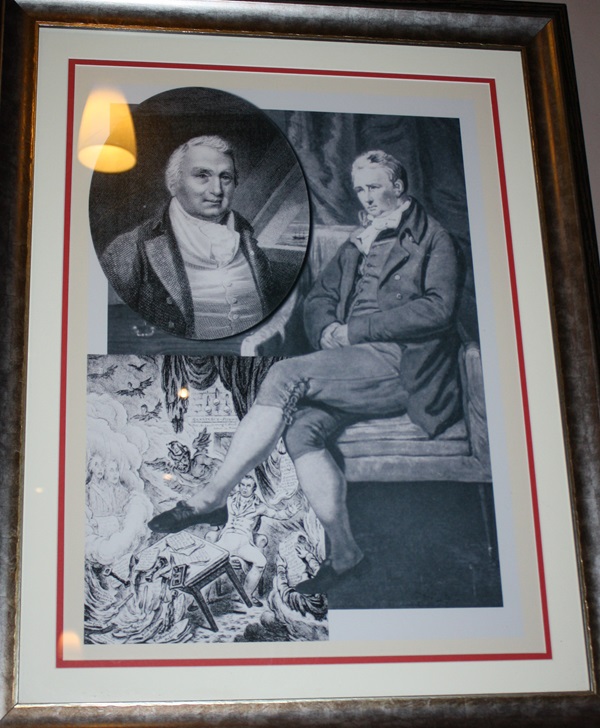
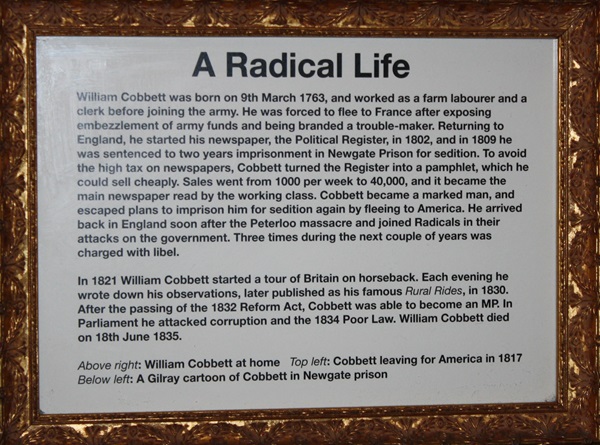
The text reads: William Cobbett was born on 9 March 1763, and worked as a farm labourer and a clerk before joining the army. He was forced to flee to France after exposing embezzlement of army funds and being branded a trouble-maker. Returning to England, he started his newspaper, the Political Register, in 1802, and in 1809 he was sentenced to two years imprisonment in Newgate Prison for sedition. To avoid the high tax on newspapers, Cobbett turned the Register into a pamphlet, which he could sell cheaply. Sales went from 1000 per week to 40,000, and it became the main newspaper read by the working class. Cobbett became a market man, and escaped plans to imprison him for sedition again by fleeing to America. He arrived back in England soon after the Peterloo massacre and joined Radicals in their attacks on the government. Three times during the next couple of years was charged with libel.
In 1821 William Cobbett started a tour of Britain on horseback. Each evening he wrote down his observations, later published as his famous Rural Rides, in 1830. After the passing of the 1832 Reform Act, Cobbett was able to become an MP. In Parliament he attacked corruption and the 1834 Poor Law. William Cobbett died on 18 June 1835.
Above right: William Cobbett at home
Top left: Cobbett leaving for America in 1817
Below left: A Gilray cartoon of Cobbett in Newgate prison.
Illustrations and text about John Wesley.
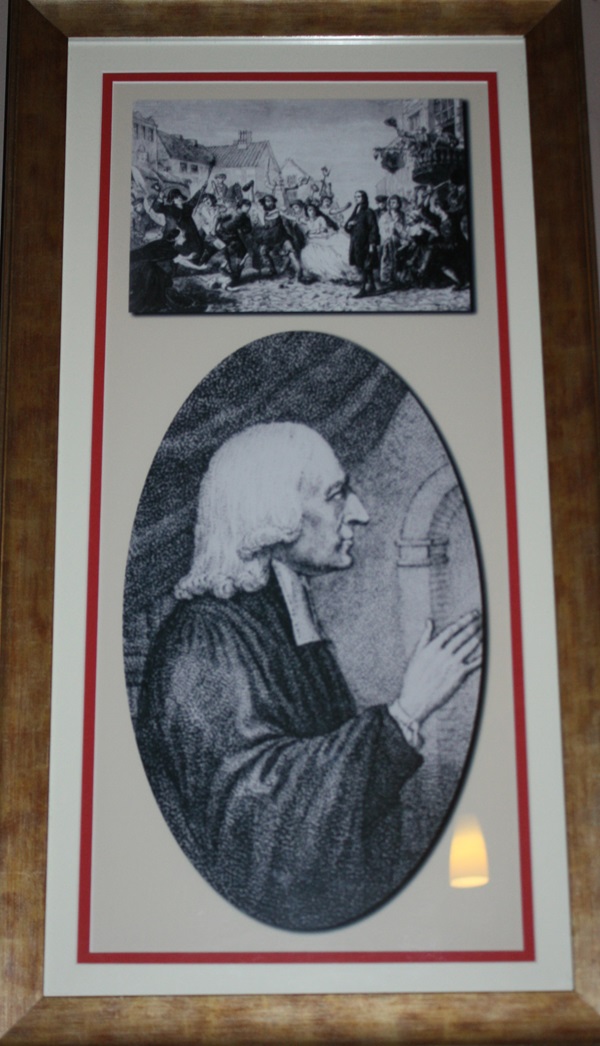
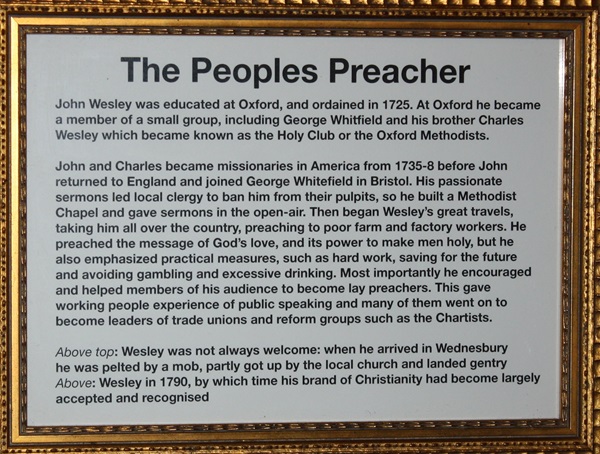
The text reads: John Wesley was educated at Oxford, and ordained in 1725. At Oxford he became a member of a small group, including George Whitfield and his brother Charles Wesley which became known as the Holy Club or the Oxford Methodists.
John and Charles became missionaries in America from 1735-8 before John returned to England and joined George Whitefield in Bristol. His passionate sermons led local clergy to ban him from their pulpits, so he built a Methodist Chapel and gave sermons in the open-air. Then began Wesley’s great travels, taking him all over the country, preaching to poor farm and factory workers. He preached the message of God’s love, and its power to make men holy, but he also emphasized practical measures, such as hard work, saving for the future and avoiding gambling and excessive drinking. Most importantly he encouraged and helped members of his audience to become lay preachers. This gave working people experience of public speaking and many of them went on to become leaders of trade unions and reform groups such as the Chartists.
Above top: Wesley was not always welcome: when he arrived in Wednesbury he was pelted by a mob, partly got up by the local church and landed gentry
Above: Wesley in 1790, by which time his brand of Christianity has become largely accepted and recognised.
An illustration and text about Spouter’s Corner.
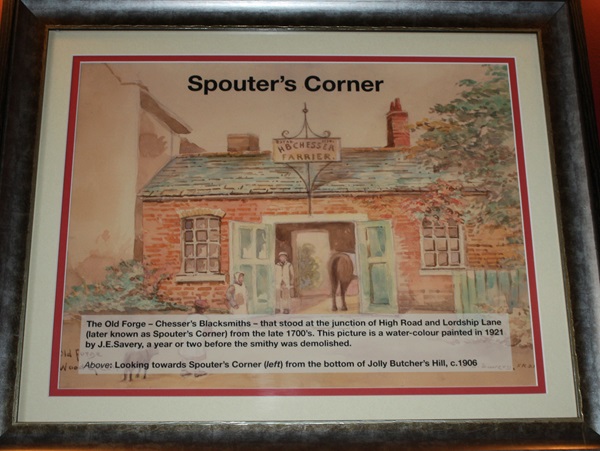
The text reads: The old Forge – Chesser’s Blacksmiths – that stood at the junction of High Road and Lordship Lane (later known as Spouter’s Corner) from the later 1700s. This picture is a water colour painted in 1921 by J. E. Savery, a year or two before the smithy was demolished.
Above: Looking towards Spouter’s Corner (left) from the bottom of Jolly Butchers Hill, c1906.
An illustration, photograph and text about the Salvation Army.
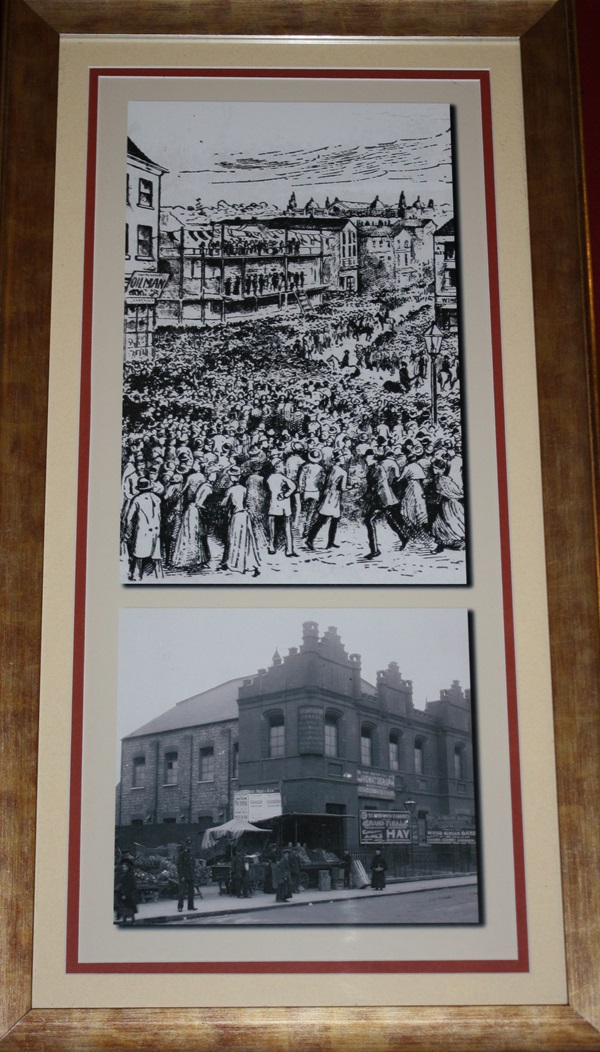
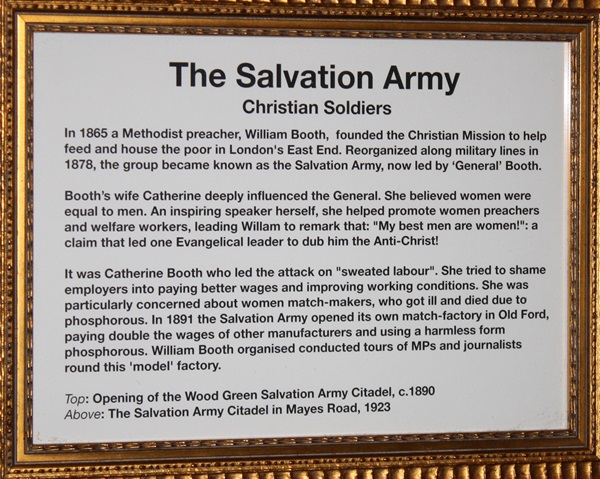
The text reads: In 1885 a Methodist preacher, William Booth, founded the Christian Mission to help feed and house the poor in London’s East End. Reorganised along military lines in 1878, the group became known as the Salvation Army, now led by ‘General’ Booth.
Booth’s wife Catherine deeply influenced the General. She believed women were equal to men. An inspiring speaker herself, she helped promote women preachers and welfare workers, leading William to remark that: “My best men are women!”: a claim that led one Evangelical leader to dub him the Anti-Christ!
It was Catherine Booth who led the attack on “sweated labour”. She tried to shame employers into paying better wages and improving working conditions. She was particularly concerned about women match-makers, who got ill and died due to phosphorous. In 1891 the Salvation Army opened its own match-factory in Old Ford, paying double the wages of other manufacturers and using a harmless form phosphorous. William Booth organised conducted tours of MPs and journalists round this ‘model’ factory.
Top: Opening of the Wood Green Salvation Army Citadel, c1890
Above: The Salvation Army Citadel in Mayes Road, 1923.
Prints and text about Wood Green Empire.

The text reads: The Wood Green Empire was built in 1912, in the section of shops in High Road known as Cheapside (just past Shopping City).
The Empire was well known for its music hall and variety acts although films were shown for a brief period when the ‘talkies’ first arrived in 1929-30. However, the Empire staged mainly live acts and musical shows until it closed as a theatre on 31 January 1955.
For a time the Empire was then used mostly for television ‘spectaculars’. The auditorium was demolished during the 1970s and the building was redeveloped as a Sainsbury’s supermarket, with the entrance in Lymington Avenue. The High Road frontage has since been converted into shops.
External photograph of the building – main entrance.
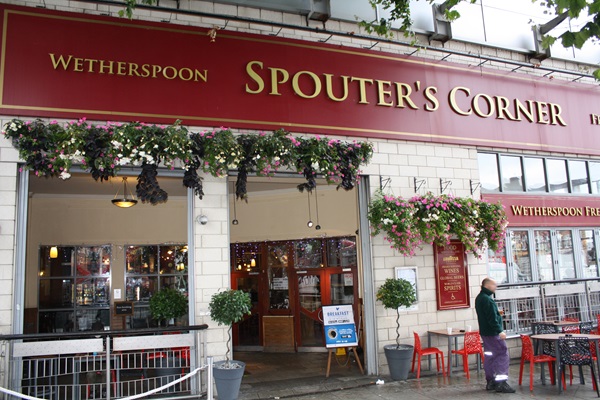
If you have information on the history of this pub, then we’d like you to share it with us. Please e-mail all information to: pubhistories@jdwetherspoon.co.uk